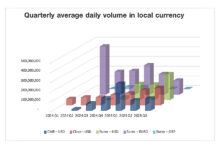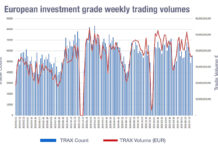A calamitous year-end in 2016 has put the broken repo market firmly in the spotlight. Lynn Strongin Dodds reports.
December 2016 saw Europe’s repurchase agreement (repo) market breakdown as a direct result of regulation. The level of dollar lending was so high that US banks hit liquidity buffers and had to cut back on overseas lending. Consequently some clients outside of the US were pushed into the swaps market where prices rocketed.
The European market for general collateral (GC) and repos for individual securities (specials) broke down on 28 December. Rates for ‘tom-next’ contracts – settling one leg one day after trade and the second leg two days after trade – for German and French GC hit approximately -8% while specials fell from -4% at open to -7%, with anecdotal reports of rates as low as -20%, according to a report by the International Capital Markets Association (ICMA).

“Dealers explained how they were unable to provide balance sheet and make prices to clients over year-end, while fund managers related stories of relationships being levered and favours being pulled to avoid being stranded over year-end,” wrote Andy Hill, a senior director at ICMA in the report on the events. “As one major blue-chip fund manager pointed out, the inability to get a repo quote on December 29, at any rate, would have technically put them in default.”
The E5.7 trillion European repo market, vital for supporting collateral, remains in critical condition and it could be many years before viable alternative liquidity solutions are developed. Electronic platforms offer hope but are in their nascent stages. Plugging directly into a central counterparty (CCP) is only viable when the costs can be justified.
“The fundamental problem is that it is becoming prohibitively expensive for the banks to fulfil their traditional role as providers of liquidity – whether that be credit intermediation, maturity transformation and/or price discovery,” says Mick Chadwick, head of Securities Finance for Aviva Investors. “This may not be such an acute issue for large fund managers like ourselves who can leverage our broader relationship with the sell side to secure the liquidity we need. However we have a duty to our clients to explore various alternative routes to market to ensure that we continue to be able to obtain best execution for them.”
Structural change
One possible solution is to use platforms that can facilitate repo transfer. Although there are initiatives being mulled over, to date there are few players. Elixium, part of Swiss interdealer broker Tradition, executed its first collateral financing transaction between buy-side collateral and liquidity providers last October, with Citibank, as cash management agent, executed on behalf of CME Clearing Europe, while Insight Investment executed on behalf of a UK pension fund.
The collateral trading platform replaces venue DBV-X a central collateral exchange for market participants, which was expected to launch last year but is now being bought by BNY Mellon.
In the meantime liquidity continues to drain out of the system due to tighter banking regulation such as the liquidity coverage ratio and leverage ratios as well as the Bank of England (BoE) and European Central Bank’s ongoing quantitative easing programmes, which are sucking high quality liquid assets out of the system. Studies show that over the past year, the ECB has bought over E1 trillion of government bonds that are typically used by banks and investors as collateral when they make short term short-term cash loans in the repo market, while in September 2016 the BoE launched a purchasing programme of £60 billion in government bonds and £10 billion in corporate bonds.

Godfried De Vidts, chairman of ICMA’s European Repo and Collateral Council, says that the 2016 year-end was the first real test for the market since the Lehman default and sovereign bond crisis when the market functioned relatively effectively.
“If the extreme volatility and dislocations witnessed at the end of December are an indication of future market resilience, we should be concerned,” he adds. “Market behaviour since the year-end, and forward pricing pressures for the March quarter-end, would seem to suggest that we may be entering a new normal for the repo market.”
Roberto Verrillo, head of Strategy and Markets at Elixium, acknowledges that there is no simple fix. and may not be for another five to ten years time, when markets evolve.
“Right now we face a democratisation of financial markets,” he says. “The problem that creates is fractious liquidity because there can be pools all over the place. That’s why we at Elixium, from a collateral perspective, want to ensure our offering is fit for purpose and be the first to market so we can build and centralise liquidity in this space.”

Verrillo adds that Elixium’s aim is to facilitate the collateralised business that the banks do not want to do because of the cost and balance sheet sensitivity. “We are providing a medium through which people can trade on a completely transparent, best price, all-to-all model,” he adds. “It’s exceptionally difficult to do because many of these counterparties have never even done repo before and those that have need to adapt their models to enable multi-client operability rather than just two to three banks.
Platforms though are not a silver bullet, according to Chadwick. “This is because you still need someone to act as principal intermediary to handle the maturity mismatch between short-term liquidity providers and longer-term liquidity takers. This will not be solved simply by posting prices on a platform,” he says.
Counterparty evolution
By mitigating counterparty risk, CCPs can make repo lighter on the balance sheet. In the repo market they proved invaluable during the financial crisis. LCH-owned RepoClear has 80 banks as members and clears approximately E150 trillion worth of cash bond and repo trades per annum across 13 European government bond markets.
“It is important to remember though that we are only one part of the market,” says Bruce Kellaway, global head of RepoClear, EquityClear and Collateral at LCH. “We create greater liquidity, and netting opportunities across trades as well as offer risk management and operational efficiency to a broad community of participants.”
Kellaway also believes that using a CCP frees up capital that banks can allocate for other activities. “It helps make their life easier by allowing greater balance sheet efficiency and they can offer services to a broader range of clients.”
However, for buy-side firms hurdles exist in their use. Investments need to be made in the right infrastructure, and membership of a CCP requires contributions to the default fund, a model of risk mutualisation which asset managers are not set up to support.
Matthew Chessum, investment dealer at Aberdeen Asset Management, says, “Being a direct member of a CCP doesn’t always work out from a cost perspective especially if you are not very active in the market. You have to take into account the margin requirements as well as the default question regarding the mutualisation of risk. There is also the issue of trade eligibility. For example, CCPs usually only accept a range of vanilla products and would not be useful if you were transacting in some emerging market products.”
Paul van de Moosdijk, senior investment manager at asset manager PGGM, echoes these sentiments. As an asset manager for pension funds, PGGM needs access to the repo markets in order to generate or post cash as collateral to meet margin calls.
“Central clearing for repo may add value but I don’t think they are an ultimate solution,” he says. “There are high barriers of entry in terms of the legal documentation and operational considerations. In addition we appreciate a diversified set of counterparties that provide liquidity.”
What the bilateral process has in its favour is a clear line-of-sight with the counterparty and a direct relationship. When using platforms, the administrative and legal process can be a challenge for fund managers as a standardised Global Master Repurchase Agreement would be needed for all counterparties, according to Van de Moosdijk.
“The other problem is the due diligence,” he adds. “We would be required to conduct credit risk analysis on a multiple of counterparties that are either small banks or non-banks which we are not equipped to do. Although this does not leave us with many solutions, I am hopeful, although not confident, that given the importance of the repo markets, the European regulators will make some adjustments to the regulation to allow us to continue using them.”
©Markets Media Europe 2025












